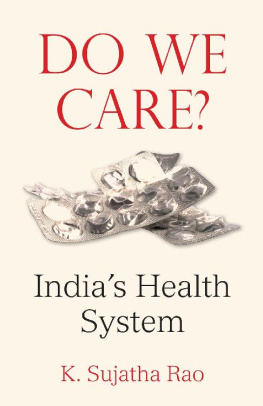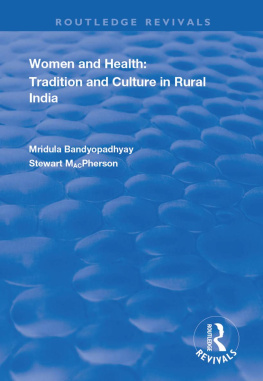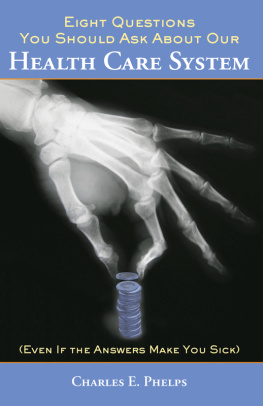DO WE CARE?
Sujatha Rao is a longtime leader in public health who has decided she has nothing to lose from telling the truth. The result is this definitive book on the Indian health systemthe tangled way it came about, how it works, where it is serving citizens well, and where it has thoroughly failed them. Do We Care? is a fearless book. Rao speaks from the heart. And she has solutions. This is a voice worth listening to.
Atul Gawande, Professor, Harvard Chan School of Public Health, and author of Being Mortal
Do We Care? is a passionate account of government failure in ensuring basic healthcare to people. Sujatha Rao brings out the glaring inadequacies of the system vividly with the anguish of denial of this basic human right. The book reflects her long years of experience, unflinching commitment, and deep analytical approach and is a must read for all health policy analysts and policymakers.
M. Govinda Rao, Member, Fourteenth Finance Commission, Government of India, and Emeritus Professor, National Institute of Public Finance and Policy, New Delhi, India.
Despite recent progress, health systems in developing countries must still contend with various challenges: promoting healthy lifestyles, preventing disease, delivering high-quality care to everyone who needs it, protecting families from the financial consequences of ill health and, underlying all of the above, closing the unacceptable gaps that so unequally allocate opportunities along gender, racial, ethnic, and socio-economic lines. Few countries better exemplify the trials that health systems in low- and middle-income countries are facing than India. For this reason, the study of this case is always revealing and enriching. Do We Care? provides a fresh and rigorous look at the past and current evolution of a national health system that offers valuable lessons for the developing world. It is a must read for scholars and decision makers interested in India, in particular, and in global health, in general.
Julio Frenk, President, University of Miami, Florida, USA, and former Minister of Health, Mexico
DO WE CARE?
Indias Health System
K. Sujatha Rao
Oxford University Press is a department of the University of Oxford.
It furthers the Universitys objective of excellence in research, scholarship,
and education by publishing worldwide. Oxford is a registered trademark of
Oxford University Press in the UK and in certain other countries.
Published in India by
Oxford University Press
YMCA Library Building, 1 Jai Singh Road, New Delhi 110001, India
Oxford University Press 2017
The moral rights of the author have been asserted.
First Edition published in 2017
All rights reserved. No part of this publication may be reproduced, stored in
a retrieval system, or transmitted, in any form or by any means, without the
prior permission in writing of Oxford University Press, or as expressly permitted
by law, by licence, or under terms agreed with the appropriate reprographics
rights organization. Enquiries concerning reproduction outside the scope of the
above should be sent to the Rights Department, Oxford University Press, at the
address above.
You must not circulate this work in any other form
and you must impose this same condition on any acquirer.
ISBN-13 (print edition): 978-0-19-946954-3
ISBN-10 (print edition): 0-19-946954-7
ISBN-13 (eBook): 978-0-19-909652-7
ISBN-10 (eBook): 0-19-909652-X
Typeset in Bembo Std 11/14
by Tranistics Data Technologies, New Delhi 110044
Printed in India by Replika Press Pvt. Ltd
For my parents and my sister Nirmala, who suffered needlessly
for want of good-quality care, and the thousands of health professionals
and caregivers saving lives in India
Contents
Tables
Figures
Boxes
The Preamble and the Directive Principles of Indias Constitution provide a direction that must underscore Indias policies and governance. Under Article 38(1), the Constitution refers to the Indian state as a welfare state, and in Article 41, it exhorts the state to strive towards extending public assistance in cases of unemployment, old age, sickness and disablement, and in other cases of undeserved want. It provides for maternity relief in Article 42; under Article 47, it states the level of nutrition and the standard of living of its people and the improvement of public health as among its primary duties; and, above all, under Article 14, all citizens have an equal right to life. However, nowhere does Indias Constitution explicitly state health as a human right.
With the years rolling by, India has gone further away from the letter and spirit of the Constitution, resulting in wide disparities and inequalities in the living standards of the people, with the rich getting richer while the vast majority of the poor continues to struggle to meet their essential needs. The state is rapidly trending towards becoming a minor player in most fields of economic and social significance. The divide between the rich and the poor could not be starker.
In other parts of the world, arguments and debates on what constitutes development, poverty, and equity has been a subject of constant reflection. During the late 1980s, the World Bank categorized countries into high-, middle-, and low-income, based on their gross domestic product (GDP). This was mainly to help decide its lending policies. In the early 1990s, a composite human development index (HDI) was developed that placed the longevity of life, female literacy, infant mortality rate (IMR), and under-five mortality rate (U5MR) alongside the GDP in order to rank countries. To some extent, the inclusion of such indicators did help in assessing the impact of GDP-measured growth on human development. But while the HDI was a useful index for advocacy purposes and raising awareness of policymakers on what should, and must, define development, it still fell short. These efforts were followed by further refinements like the inequality-adjusted HDI, gender inequality index, gender development index, and so on.
Of late, scholars are measuring poverty and equity by associating other factors to develop a multidimensional poverty index (MPI). The MPI seeks to capture poverty in terms of the consequential deprivation or the clustered disadvantage that a poor person faces in accessing basic goods like education, healthcare, safe water, nutrition, environmental hygiene, and such related elements that are required to enhance ones capability to live life to the optimum and also, in a more utilitarian sense, access opportunities for ones betterment. A further refinement of indices to categorize countries in terms of disease and well-being is now being attempted for channelizing development aid and financial flows. Such a redefinition has been necessitated since 70 per cent of disease and health inequity is concentrated in the low-income and middle-income countries, challenging the notion that incomes do not, by themselves, ensure the health and well-being of a people. Thus, while there are several studies that show strong correlations between economic growth and poverty reduction, there are not many to show the correlation between growth and non-income related indicators.
It is in this context that the report of the Commission on Macroeconomics and Health (CMH) published in 2000 by the World Health Organization (WHO) was a landmark of sorts for clearly establishing the link between health and wealth, between the development of a society and economic prosperity. The CMH report argued that healthy people generate wealth, and ill health and disease significantly impact the growth momentum. In an ageing world, Indias 40 per cent young and productive population can be, and is, an enviable advantage, but only if they are healthy. Sick people do not produce wealth.











